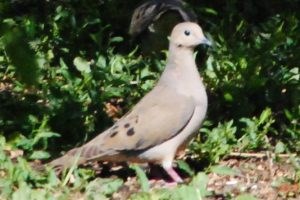This content was originally published by the Longmont Observer and is licensed under a Creative Commons license.
When Doves Fly
Christi Yoder
As a young girl growing up on a small farm in rural Minnesota, I often heard the haunting cooing of the mourning dove. When my dad first asked me if I knew what kind of bird that was, I thought it was an owl, so similar are the sounds. I continued to enjoy seeing these beautiful birds when I moved to Colorado. But within the last ten years, an interloper has come along that has scientists worried for the future of the mourning dove. This interloper is known as the Eurasian collared dove.
The Eurasian collared dove is an invasive species that originally came from a pet shop in the Bahamas in 1974 where they had also been introduced. The story goes that the pet store was robbed and several of the birds got loose during the robbery. The pet store owner then decided to release the remainder of the birds into the wild. Like most invasive species, the Eurasian collared dove is highly adaptable and it soon found its way to the US. The first one was spotted in Colorado in 1996 during the Audubon Society’s Christmas bird count. Since then, it has spread throughout Colorado and can now be found in every county.
Eurasian collared doves are found wherever there are humans, including farmlands and suburbs. You can often see these birds feeding on the ground near backyard bird feeders. A large part of their diet is made up of seeds, but they also will eat some fruit and insects. In addition, they will eat food humans provide, such as bread crumbs.
The breeding display of the Eurasian collared dove is highly ritualized with the male giving a display during flight. This consists of the male flying up steeply, then descending in a spiral with his wings and tail spread, all the while calling to the female. The male also “bows” repeatedly to the female while cooing. Once the pair has formed, they are monogamous. The male will show the female various nesting sites, but ultimately, the female chooses the site. Nests can be found in trees, shrubs, or manmade structures and are flimsy platform nests consisting of a few twigs. The male brings the material to the female and she builds the nest.
The Eurasian collared dove is a prolific breeder, laying two eggs at a time, but breeding up to six times per year. The pair shares the duties of incubation which last for 14-18 days. Pigeons and doves are unique in their ability to create what is known as “crop milk”, a highly nutritious substance, to feed their young. Both parents are able to produce this milk. The young leave the nest at about 15-20 days and stay near their parents for about another week.
Since the introduction of the Eurasian collared dove, scientists have been worried that, like most invasive species, it might outcompete or even interbreed with the mourning dove. Studies done on the diets of the two dove species show significant overlap. However, the mourning dove seems to be peacefully living alongside the Eurasian collared dove for the most part at present. It remains to be seen in the future whether this trend will continue to hold true. Eurasian collared doves can be hunted, and this may be helping maintain a healthy relationship with the mourning dove.
You can distinguish the Eurasian collared dove from the mourning dove by sight and sound. The Eurasian collared dove sports a prominent black band or “collar” around the back half of its neck, white patches in its tail, and has dark-tipped wings. Its body is also heavier than that of a mourning dove and is slightly larger. They have a square tail as compared to the mourning dove which has more of a pointed tail.
Mourning doves have black spots on their wings and white-tipped feathers bordered in black all the way to the tail.

Christi Yoder is a former wildlife biologist. This column (The Longmont Weekly Wild) will be a weekly column on all things backyard and local wildlife and wild things. If you have questions about wildlife, please send them to the Longmont Observer ([email protected]) or add them to the comments and we will try to answer them in an upcoming column.


